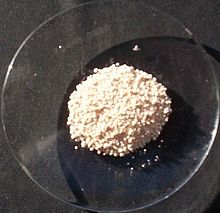
Back أكسيد الهافنيوم الرباعي Arabic اوکسید هافنیوم (IV) AZB Òxid d'hafni(IV) Catalan Oxid hafničitý Czech Hafnium(IV)-oxid German Óxido de hafnio (IV) Spanish اکسید هافنیم (IV) Persian Hafnium(IV)oksidi Finnish Oxyde d'hafnium(IV) French תחמוצת הפניום HE

| |

| |
| Names | |
|---|---|
| IUPAC name
Hafnium(IV) oxide
| |
| Other names
Hafnium dioxide
Hafnia | |
| Identifiers | |
3D model (JSmol)
|
|
| ChemSpider | |
| ECHA InfoCard | 100.031.818 |
| EC Number |
|
PubChem CID
|
|
| UNII | |
CompTox Dashboard (EPA)
|
|
| |
| |
| Properties | |
| HfO2 | |
| Molar mass | 210.49 g/mol |
| Appearance | off-white powder |
| Density | 9.68 g/cm3, solid |
| Melting point | 2,758 °C (4,996 °F; 3,031 K) |
| Boiling point | 5,400 °C (9,750 °F; 5,670 K) |
| insoluble | |
| −23.0·10−6 cm3/mol | |
| Hazards | |
| Flash point | Non-flammable |
| Related compounds | |
Other cations
|
Titanium(IV) oxide Zirconium(IV) oxide |
Related compounds
|
Hafnium nitride |
Except where otherwise noted, data are given for materials in their standard state (at 25 °C [77 °F], 100 kPa).
| |
Hafnium(IV) oxide is the inorganic compound with the formula HfO
2. Also known as hafnium dioxide or hafnia, this colourless solid is one of the most common and stable compounds of hafnium. It is an electrical insulator with a band gap of 5.3~5.7 eV.[1] Hafnium dioxide is an intermediate in some processes that give hafnium metal.
Hafnium(IV) oxide is quite inert. It reacts with strong acids such as concentrated sulfuric acid and with strong bases. It dissolves slowly in hydrofluoric acid to give fluorohafnate anions. At elevated temperatures, it reacts with chlorine in the presence of graphite or carbon tetrachloride to give hafnium tetrachloride.
- ^ Bersch, Eric; et al. (2008). "Band offsets of ultrathin high-k oxide films with Si". Phys. Rev. B. 78 (8): 085114. Bibcode:2008PhRvB..78h5114B. doi:10.1103/PhysRevB.78.085114.